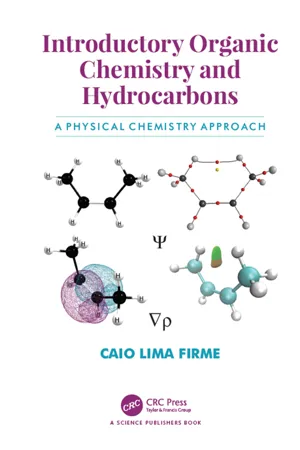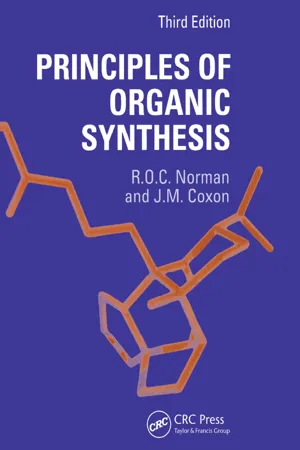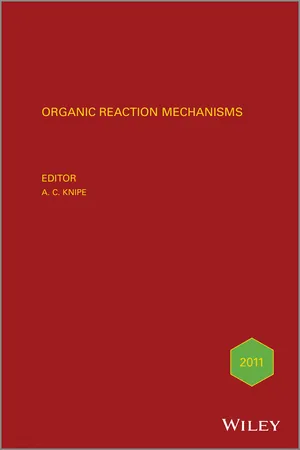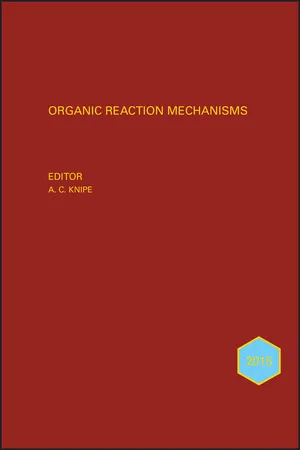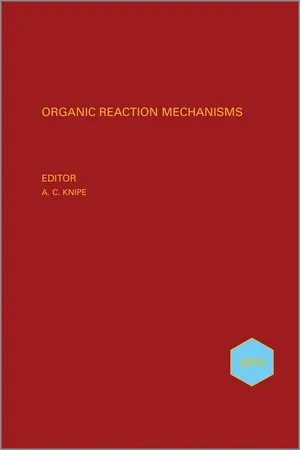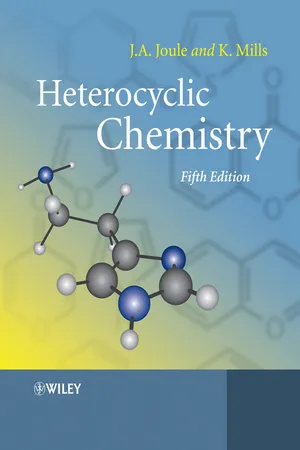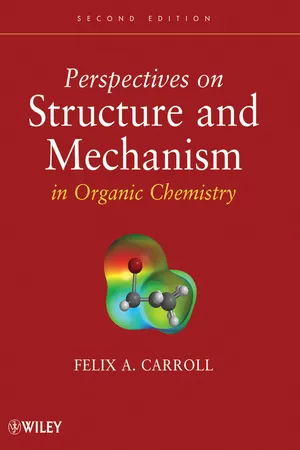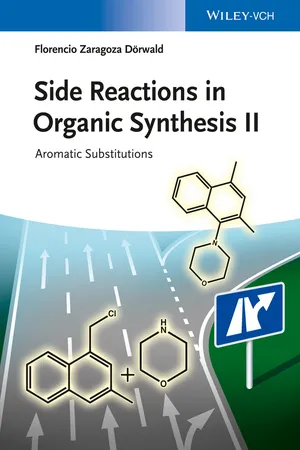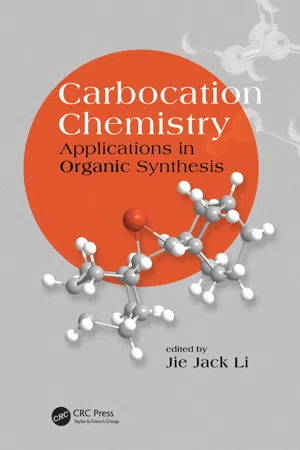Chemistry
Electrophilic Substitution of Benzene
Electrophilic substitution of benzene is a chemical reaction in which an electrophile replaces a hydrogen atom on a benzene ring. This process occurs due to the high electron density of the benzene ring, making it susceptible to attack by electrophiles. The reaction is important in organic chemistry for the synthesis of various aromatic compounds.
Written by Perlego with AI-assistance
Related key terms
Related key terms
1 of 4
Related key terms
1 of 3
10 Key excerpts on "Electrophilic Substitution of Benzene"
- eBook - ePub
Introductory Organic Chemistry and Hydrocarbons
A Physical Chemistry Approach
- Caio Lima Firme(Author)
- 2019(Publication Date)
- CRC Press(Publisher)
Chapter TwentySubstituent Groups and Electrophilic Aromatic Substitution
INTRODUCTION
Benzene, as the most important representative of aromatic compounds, normally does not undergo addition reaction unless under very drastic conditions. While cyclohexene and 1,3-cyclohexadiene undergo bromination (normal addition reaction in darkness and impurity-free solvent), bromine cannot react with benzene even under light exposure by addition reaction (Fig. 20.1(A) ). However, in a catalyzed synthesis, benzene can react with bromine in a substitution reaction rather than an addition reaction. Then, aromaticity in benzene changes its reaction behavior drastically in comparison with other unsaturated molecules.Reactants such as bromine, chlorine, nitric acid, sulfur trioxide, and alkyl/acyl halides, using catalysists (except for sulfur trioxide) can react as electrophiles with benzene (besides other benzenoid and five-membered heteroaromatic systems). In this case, benzene (and other benzenoid/five-membered heteroaromatic compounds) reacts as a nucleophile. As mentioned above, in this reaction, a substitution occurs instead of an addition reaction, i.e., the hydrogen atom from benzene is exchanged by the electrophile, E. In another words, the net result of this reaction is that the E replaces H in benzenoid ring without eliminating its aromaticity. This reaction is known as electrophilic aromatic substitution, EAS.Sometimes, the mechanism for electrophilic aromatic substitution is known as Wheland mechanism because it passes through the Wheland intermediate or σ-complex (Fig. 20.1(B) ). In 1942, G.W. Wheland was the first to propose theoretically the existence of the arenium ion (the σ - eBook - ePub
- Richard O.C. Norman(Author)
- 2017(Publication Date)
- Routledge(Publisher)
Electrophilic aromatic substitution 11 11.1 The mechanism of substitutionThe substitution of benzene by an electrophilic reagent (E+ ) occurs in two stages: the reagent adds to one carbon atom of the nucleus, giving a carbocation in which the positive charge is delocalized over three carbon atoms, and a proton is then eliminated from this adduct:The electrophile may be a charged species, such as the nitronium ion,and those such as the halogens in which uptake of the electron-pair leads to bond breakage and the formation of a stable anion, The following are the chief characteristics of these reactions.NO 2 +, which participates in nitration (section 11.4 ), and the t-butyl cation, (CH3 )3 C+ , which participates in Friedel-Crafts t-butylation (section 11.3 ), or it may be a neutral species which can absorb the pair of electrons provided by the aromatic nucleus. The latter class includes reagents such as sulfur trioxide (in sulfonation, section 11.5 ) which absorb the electron-pair without bond breakage,(1) The intermediate carbocation adducts are too unstable to be isolated as salts except in special circumstances. For example, benzotrifluoride reacts with nitryl fluoride (NO2 F) and boron trifluoride at low temperatures to give a crystalline product thought to be the salt,This product is stable only to −50°C, above which it decomposes into m-nitrobenzotrifluoride, hydrogen fluoride, and boron trifluoride. The relative stability of this adduct is associated with the stability of the fluoroborate anion.(2) In most instances, the first step in the process is rate-determining, e.g. in the nitration and bromination of benzene. There are some reactions in which the second step (loss of the proton) is rate-determining; sulfonation is the best known example.(3) The reactions are, with few exceptions, irreversible and the products formed are kinetically controlled (p. 68 ). Two important exceptions are sulfonation (section 11.5 ) and Friedel-Crafts alkylation (section 11.3 a); the reversibility of these reactions can lead to the formation of the thermodynamically controlled products in appropriate conditions. Use may be made of this fact in synthesis (p. 364 ), but in some situations it proves to be disadvantageous (p. 390 - eBook - ePub
- Andrew F. Parsons(Author)
- 2013(Publication Date)
- Wiley(Publisher)
2 groups, respectively. This electrophilic substitution reaction (with the diazonium salt as the electrophile) produces highly coloured azo compounds.Steric effects and electrophilic substitution is discussed in Section 7.3.2.47.7 Reduction of the Benzene Ring
Harsh reaction conditions are required to reduce the aromatic benzene ring. This can be achieved by catalytic hydrogenation (using high temperatures or pressures and very active catalysts) or alkali metals in liquid ammonia/ethanol (in a Birch reduction ).Catalytic hydrogenation of alkenes and alkynes is discussed in Section 6.3.2.4Catalytic Hydrogenation
In the chair conformation of a substituted cyclohexane, the substituent (R) sits in an equatorial position (Section 3.2.4)Birch Reduction
Sodium or lithium metal (in liquid ammonia) can donate an electron to the benzene ring to form a radical anion (R√− ). On protonation (by ethanol, EtOH) and further reduction then protonation, this produces 1,4-cyclohexadiene.Addition of an electron to a neutral organic compound forms a radical anion; loss of an electron from a neutral organic compound forms a radical cation (Section 10.1.1) For a related reduction of an alkyne, see Section 6.3.2.47.8 The Synthesis of Substituted Benzenes
The following points should be borne in mind when planning an efficient synthesis of a substituted benzene.1. The introduction of an activating group on to a benzene ring makes the product more reactive than the starting material. It is therefore difficult to stop after the first substitution. This is observed for Friedel-Crafts alkylations. Activating groups donate electron density toward the benzene ring (Section 7.3.1)An alkyl group is an ortho -/para -directing activatorThe mechanism of Friedel-Crafts alkylation is discussed in Section 7.2.42. The introduction of a deactivating group on to a benzene ring makes the product less reactive than the starting material. Therefore multiple substitutions do not occur, for example, in Friedel-Crafts acylations (to give ketones, e.g. ArCOR). The ketone (ArCOR) could then be reduced to give the mono-alkylated product (ArCH2 R) in generally higher yield than that derived from a Friedel-Crafts alkylation. The mechanism of Friedel-Crafts acylation is discussed in Section 7.2.5 The Clemmensen reduction is introduced in Section 7.6 - eBook - ePub
Organic Reaction Mechanisms 2011
An annual survey covering the literature dated January to December 2011
- A. C. Knipe, A. C. Knipe(Authors)
- 2014(Publication Date)
- Wiley(Publisher)
Chapter 6 Electrophilic Aromatic Substitution M. R. CramptonDepartment of Chemistry, University of Durham, Durham, UK- General
- Halogenation
- Nitration and Sulfonation
- Alkylations, Arylation, and Acylation Reactions
- Substitution on Heterocyclic Rings
- Other Reactions
- References
General
A comparison of different measures of nucleophilicity using reactions of some phenols, indoles, and bicyclic heptadienes has concluded that the nucleophilicity N index best describes the reactivity of complex organic molecules with electrophiles.1 An ab initio study using valence-bond calculations has been made of the regioselectivity of substitution in monosubstituted benzenes. For an amino substituent, the preferential ortho/para attack is shown to result from stronger π-donation than in the meta case. However, the deactivating influence of a nitro-group is likely to result from a destabilizing σ-attracting effect that is not counterbalanced by the π-stabilizing effect.2 The theoretical technique of interaction energy decomposition potentials has also been used to examine the basis of regioselectivity in reactions of benzene derivatives with electrophiles; the importance of orbital interactions was stressed.3 There has been a review of the derivation and applications of orbital phase theory.4 An ab initio study has been reported of regioselectivity in chlorination reactions of bithiophenes,5 and there has been a density functional theory (DFT ) study of the regioselectivity of substitution in polychlororoanilines.6 - eBook - ePub
Organic Reaction Mechanisms 2013
An annual survey covering the literature dated January to December 2013
- A. C. Knipe, A. C. Knipe(Authors)
- 2016(Publication Date)
- Wiley(Publisher)
Chapter 5 Aromatic SubstitutionM. R. CramptonDepartment of Chemistry, University of Durham, Durham, UK- Introduction
- General
- Nucleophilic Substitutions
- The SN Ar Mechanism
- Meisenheimer and Related Adducts
- Benzyne and Related Intermediates
- Electrophilic Substitutions
- Halogenation
- Nitration
- Bond Formation to Sulfur, Oxygen, and Nitrogen
- Alkylation, Arylation, and Acylation
- Other Reactions
- Transition-Metal-Catalysed Carbon–Carbon Bond Formation
- Alkylation, Arylation, and Acylation
- Transition-metal-catalysed Substitutions on Heterocyclic Rings
- References
Introduction
As happened last year, the chapters on nucleophilic and electrophilic substitution have been combined. The importance of transition-metal-catalysed reactions continues to increase, and their uses in substitutions involving carbon–carbon bond formation are gathered in a single section. This follows sections involving more traditional mechanisms involving bond formation to oxygen, nitrogen, sulfur, and the halogens, although here too transition-metal-catalysis may be involved.General
An examination of the enthalpies of complete hydrogenation of the rings of monosubstituted benzenes shows that the values reflect the electrophilic reactivities of the arenes. The orientation of substitution is controlled by the direction of the carbon-substituent dipole.1 There has been a review of the use of the electrostatic potentials at nuclei and electrophile affinity indices in predicting the reactivities of arenes in electrophilic substitutions.2 The electrophilic reactivity of linear acenes has been investigated using interaction energy potentials with copper(I) as a model electrophile; reactivity was shown to increase with length of the acene.3 A computational study of substitution in azulene has also been reported.4 - eBook - ePub
Organic Reaction Mechanisms 2010
An annual survey covering the literature dated January to December 2010
- A. C. Knipe, A. C. Knipe(Authors)
- 2012(Publication Date)
- Wiley(Publisher)
Chapter 6 Electrophilic Aromatic Substitution M. R. CramptonDepartment of Chemistry, University of Durham, Durham, UKGeneral Halogenation Nitration Alkylation, Acylation, and Arylation Reactions Substitutions on Heterocyclic Rings Other Reactions ReferencesGeneral
Interest in electrophilic substitutions continues to expand, with the number of relevant references more than doubling between 2008 and 2010. Much of this interest is concerned with metal-catalysed reactions and in substitutions on heterocyclic compounds.There has been a theoretical study1 of the relative reactivity and site selectivity of substituted phenols, anisoles, pyrroles, and indoles. The method uses four known equations assessing quantities such as local and global softness and hardness, and the nucleophilicity values, N, obtained are in reasonable agreement with experimental values obtained from work from Mayr's group. Density functional theory (DFT) has been used to assess the proton affinity and protonation sites of p-nitroaniline2 and to investigate protonation and methylation pathways for benzene, leading to both kinetically controlled and thermodynamically controlled products.3 An ab initio study of proton transfers between five-membered heterocyclic rings has considered the interplay of resonance, inductive, and polarizability effects together with aromaticity and antiaromaticity. An important conclusion is that, in proton transfers that lead to an aromatic molecule or ion, the development of aromaticity runs ahead of the proton transfer, leading to a lowering of the intrinsic reactivity barrier.4 Platinum and palladium complexes incorporating cationic pyridinium ligands have been shown to be effective catalysts for hydrogen/deuterium exchange in benzene and substituted arenes.5 - eBook - ePub
- John A. Joule, Keith Mills(Authors)
- 2013(Publication Date)
- Wiley-Blackwell(Publisher)
3.1), or indeed with any other electrophilic species in the proposed reaction mixture (protons in a nitrating mixture, or aluminium chloride in a Friedel-Crafts combination), will take place far faster than any C -substitution, thus converting the substrate into a positively charged salt and therefore enormously reducing its susceptibility to attack by El + at carbon. It is worth recalling the rate reduction attendant upon the change from benzene to the N,N,N -trimethylanilinium cation (PhN + Me 3), where the electrophilic substitution rate goes down by a factor of 10 8, even though in this instance the charged atom is only attached to, and not a component of, the aromatic ring. Thus all heterocycles with a pyridine-type nitrogen (i.e. those containing C=N) do not easily undergo C -electrophilic substitution, unless: (i) there are other substituents on the ring which ‘activate’ it for attack or (ii) the molecule has another, fused benzene ring in which substitution can take place. For example, simple pyridines do not undergo many useful electrophilic substitutions, but quinolines and isoquinolines undergo substitution in the benzene ring. It has been estimated that the intrinsic reactivity of pyridine (i.e - No longer available |Learn more
- Felix A. Carroll(Author)
- 2011(Publication Date)
- Wiley(Publisher)
p orbitals on ring substituents is precluded. In other words, the geometry of the carbanion prevents resonance interactions between the carbanion and the substituent, so the effect of a substituent in benzyne reactions is limited to inductive (field) effects. Due to the electronegativity of oxygen, methoxy is electron-withdrawing by induction, so its effect is qualitatively the same as trifluoromethyl. This example shows the potential pitfalls in transferring models from one reaction to another without explicitly considering the underlying bases of those models.Effect of substituent on elimina tion step in benzyne mechanism: favored pathway if R is electron-withdrawing.FIGURE 8.64Effect of substituent on addition step in benzyne mechanism: fa vored pathway if R is electron-donating.FIGURE 8.65Effect of substituent on addition step in benzyne mechanism: fa vored pathway if R is electron-with drawing.FIGURE 8.66Representations of benzyne.FIGURE 8.67One other aspect of benzyne chemistry deserves mention. We have drawn the benzyne structure as 86 (Figure 8.67 ), which might be called the aryne representation. We cannot a priori state that a structure with what is formally one triple bond and two double bonds in a six-membered ring is more stable than a structure with four double bonds, which is the cumulene representation of benzyne (91). We should also consider the possibility of some biradical nature of benzyne, as suggested by the resonance structures 92 and 93. There have been several attempts to determine experimentally and theoretically which drawing is the best graphical representation of benzyne, and Laing and Berry found that analysis of infrared absorption bands of matrix-isolated benzyne suggested the aryne structure (86). 239 - eBook - ePub
Side Reactions in Organic Synthesis II
Aromatic Substitutions
- Florencio Zaragoza Dörwald(Author)
- 2014(Publication Date)
- Wiley-VCH(Publisher)
8 Aromatic Nucleophilic Substitutions8.1 General Aspects
Although less important than aromatic electrophilic substitutions, aromatic nucleophilic substitutions are valuable transformations in organic synthesis. Many drugs, agrochemicals, and other structurally complex compounds comprise aromatic nucleophilic substitutions in their industrial syntheses. Numerous reviews have been published [1–4].8.1.1 Mechanisms
Aromatic nucleophilic substitutions can proceed by an addition–elimination mechanism (SN Ar), by an abstraction–addition mechanism (SN 1), via radicals (SRN 1), or via intermediate formation of an aryne (Scheme 8.1 ). The first mechanism is predominant for electron-deficient arenes or heteroarenes capable of delocalizing a negative charge to electronegative atoms. Electron-withdrawing groups in the ortho or para position to the leaving group enhance the rate of SN Ar reactions, whereas electron-donating groups inhibit them. Particularly powerful rate-enhancing groups are diazonium, iminium, nitroso, and nitro groups.Mechanisms of aromatic nucleophilic substitution.Scheme 8.1Naphthyl derivatives undergo SN Ar reactions particularly readily (Scheme 8.2 ) because the dearomatization of naphthalenes requires less energy than that of monocyclic arenes (only one of the two rings of naphthalene is fully aromatic) [5, 6]. 2-Nitronaphthalenes, for instance, behave chemically more as nitroalkenes than as nitroarenes [7].SN Ar reaction at naphthalenes [6, 8, 9].Scheme 8.28.1.2 Regioselectivity
Because the addition of a nucleophile to an electron-deficient arene is reversible, smooth substitutions will occur only at arenes with good leaving groups. For SN Ar reactions, good leaving groups include fluoride, nitrite, sulfonates, the remaining halides, and sulfinates. In the presence of oxidants, hydride may also be a suitable leaving group. The precise ranking of leaving groups also depends on the solvent (solvation of the nucleophile, the Meisenheimer complex, and the leaving group) and on the nucleophile (hydrogen bonding in the Meisenheimer complex) [10–12]. The amino group, for instance, is a poor leaving group in aprotic solvents, but is easier to displace than chloride by hydroxide in water as solvent (Scheme 8.3 ). 6-(Alkylsulfonyl)purines react faster with MeOH/DBU (1,8-diazabicyclo[5.4.0]undec-5-ene) than 6-iodopurines, but more slowly with aniline than 6-iodopurines [13]. A further example of solvent effects in aromatic nucleophilic substitutions is given in Scheme 8.4 - eBook - ePub
Carbocation Chemistry
Applications in Organic Synthesis
- Jie Jack Li(Author)
- 2016(Publication Date)
- CRC Press(Publisher)
5 Electrophilic Aromatic Substitution Jie Jack LiCONTENTS
5.1 Introduction 5.2 Nitration 5.3 Halogenation 5.4 Friedel–Crafts Alkylation 5.5 Friedel–Crafts Acylation 5.6 Applications of Friedel–Crafts Reaction on Total Synthesis 5.6.1 Friedel–Crafts Alkylation 5.6.2 Friedel–Crafts Acylation 5.7 Miscellaneous EAS Reactions References5.1 INTRODUCTION
Electrophilic aromatic substitution is also known as EAS or SE Ar for short. On this topic, in 1990, Taylor published a book titled Electrophilic Aromatic Substitution .1 In this chapter, key advancements in the field of EAS are summarized.The most fundamental mechanism for EAS reaction is the Ingold–Hughes mechanism shown below.2 More sophisticated mechanisms have been put forward,3 with the most popular one invoking π complex 4 and σ complex 2 .In 2003, Lenoir highlighted the electrophilic substitution of arenes.4 The textbook perception of the mechanism of such reactions may be represented as 1 → 3 with the key intermediate as π complex 4 . The nature of the σ complex is relatively straightforward, the nature of the π complex 4 is less clear although Benesi and Hildebrand first established the existence of π or charge-transfer (CT) complexes in 1949 from the characteristic CT bands in the UV/Vis spectrum. In 1991, Kochi et al. derived a symmetrical over-ring structure similar to 4 for the complex from mesitylene and NO. In early 2000s, Kochi et al. demonstrated the existence of CT complexes as a key intermediate in the bromination of benzene and toluene by isolating different arene–bromine CT complexes and determined the x-ray crystal structure at −150°C. Another mechanism involves the intermediacy of radical pair 5 while a third mechanism involves a combination of π complex 4 and radical pair 5
Index pages curate the most relevant extracts from our library of academic textbooks. They’ve been created using an in-house natural language model (NLM), each adding context and meaning to key research topics.
Explore more topic indexes
Explore more topic indexes
1 of 6
Explore more topic indexes
1 of 4
